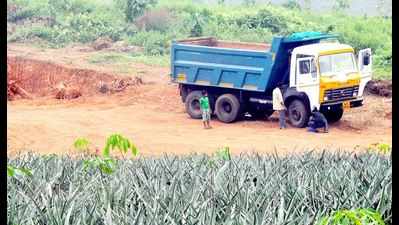- News
- City News
- thiruvananthapuram News
- Calamity-hit Kerala mulls regulation
Trending
This story is from August 23, 2019
Calamity-hit Kerala mulls regulation
As concerns grow over human interventions that are triggering fatal natural hazards, state government is mulling serious regulatory measures on mining activities in ecologically-sensitive areas (ESAs) and places identified under landslide zonation.

The state-level expert appraisal committee (SEAC) had recently recommended green clearance for six quarries in August. (File Photo)
THIRUVANANTHAPURAM: As concerns grow over human interventions that are triggering fatal natural hazards, state government is mulling serious regulatory measures on mining activities in ecologically-sensitive areas (ESAs) and places identified under landslide zonation.
The department of environment has initiated talks with expert groups on mapping susceptible areas and then check quarrying activities completely in such places.National centre for earth science studies (NCESS) is already working on updating landslide zonation map which was prepared in 2009.
“Banning quarrying in ESAs is being considered seriously. The government is considering steps to strictly monitor the violations of environmental clearance conditions and amendment of regulations wherever necessary,” said Usha Titus, principal secretary (environment). A meeting in this regard was held on Tuesday.
Between 2012 and 2019, state environmental impact assessment authority (SEIAA) had issued environmental clearance to over 250 quarries across the state.
Kumar, an assistant professor at University of Kerala’s geology department who has studied landslides extensively, says that all factors will have to be considered in case of a landslide.
“Mining and quarrying definitely influence landslide by acting as triggers during periods of heavy rainfall. Ideal techniques should be adopted for mining in areas prone to landslides. There should be a code for construction and mining activities. We should have a system wherein survey numbers of landslide-prone areas across the state have to be published and disseminated among the public. The effect of quarrying in vulnerable areas can be minimized by the use of controlled blasting for mining and stopping mining during monsoon season,” he said.
Of late, SEAC and SEIAA have red-flagged quarry projects in some cases. In July, SEIAA decided to reject the proposal for a building stone quarry project at Iritty in Kannur citing that the area was ecologically-fragile and prone to landslides.
SEIAA had also sought clearance from Idukki wildlife sanctuary warden while considering an application for quarry project at Peermade taluk. The authority demanded clearance from wildlife warden after it noticed that the proposed quarry area is within a 10km distance from the protected area. SEAC recently directed a project proponent to submit certificate from district disaster management authority regarding a building stone quarry project at Melmuri village, Malappuram.
The department of environment has initiated talks with expert groups on mapping susceptible areas and then check quarrying activities completely in such places.National centre for earth science studies (NCESS) is already working on updating landslide zonation map which was prepared in 2009.
“Banning quarrying in ESAs is being considered seriously. The government is considering steps to strictly monitor the violations of environmental clearance conditions and amendment of regulations wherever necessary,” said Usha Titus, principal secretary (environment). A meeting in this regard was held on Tuesday.
Between 2012 and 2019, state environmental impact assessment authority (SEIAA) had issued environmental clearance to over 250 quarries across the state.
The state-level expert appraisal committee (SEAC) had recently recommended green clearance for six quarries in August. A study on effect of quarrying on the slope stability in Banasuramala by KS Sajin Kumar, G Sankar, V R Rani and P Sundararajan noted that the blasting and crushing cause ground vibrations in and around the quarry and crusher site. Its impacts depend on the intensity and magnitude of the blast and the ensuing vibration that is generated. The impact domain for a blast with 0.2kg is a 60m radius and it increases with quantity of explosives. Localized vibrations could trigger landslides, enhance soil erosion and destabilize rock boulders on the side slopes of the hillock, the study said.
Kumar, an assistant professor at University of Kerala’s geology department who has studied landslides extensively, says that all factors will have to be considered in case of a landslide.
“Mining and quarrying definitely influence landslide by acting as triggers during periods of heavy rainfall. Ideal techniques should be adopted for mining in areas prone to landslides. There should be a code for construction and mining activities. We should have a system wherein survey numbers of landslide-prone areas across the state have to be published and disseminated among the public. The effect of quarrying in vulnerable areas can be minimized by the use of controlled blasting for mining and stopping mining during monsoon season,” he said.
Of late, SEAC and SEIAA have red-flagged quarry projects in some cases. In July, SEIAA decided to reject the proposal for a building stone quarry project at Iritty in Kannur citing that the area was ecologically-fragile and prone to landslides.
SEIAA had also sought clearance from Idukki wildlife sanctuary warden while considering an application for quarry project at Peermade taluk. The authority demanded clearance from wildlife warden after it noticed that the proposed quarry area is within a 10km distance from the protected area. SEAC recently directed a project proponent to submit certificate from district disaster management authority regarding a building stone quarry project at Melmuri village, Malappuram.
End of Article
FOLLOW US ON SOCIAL MEDIA










